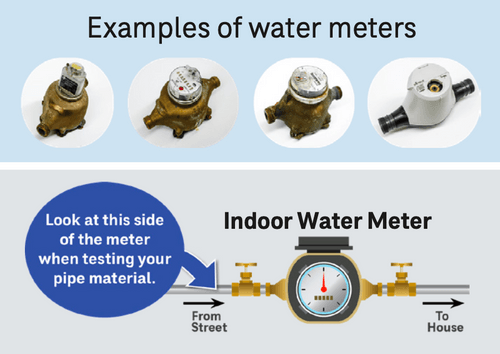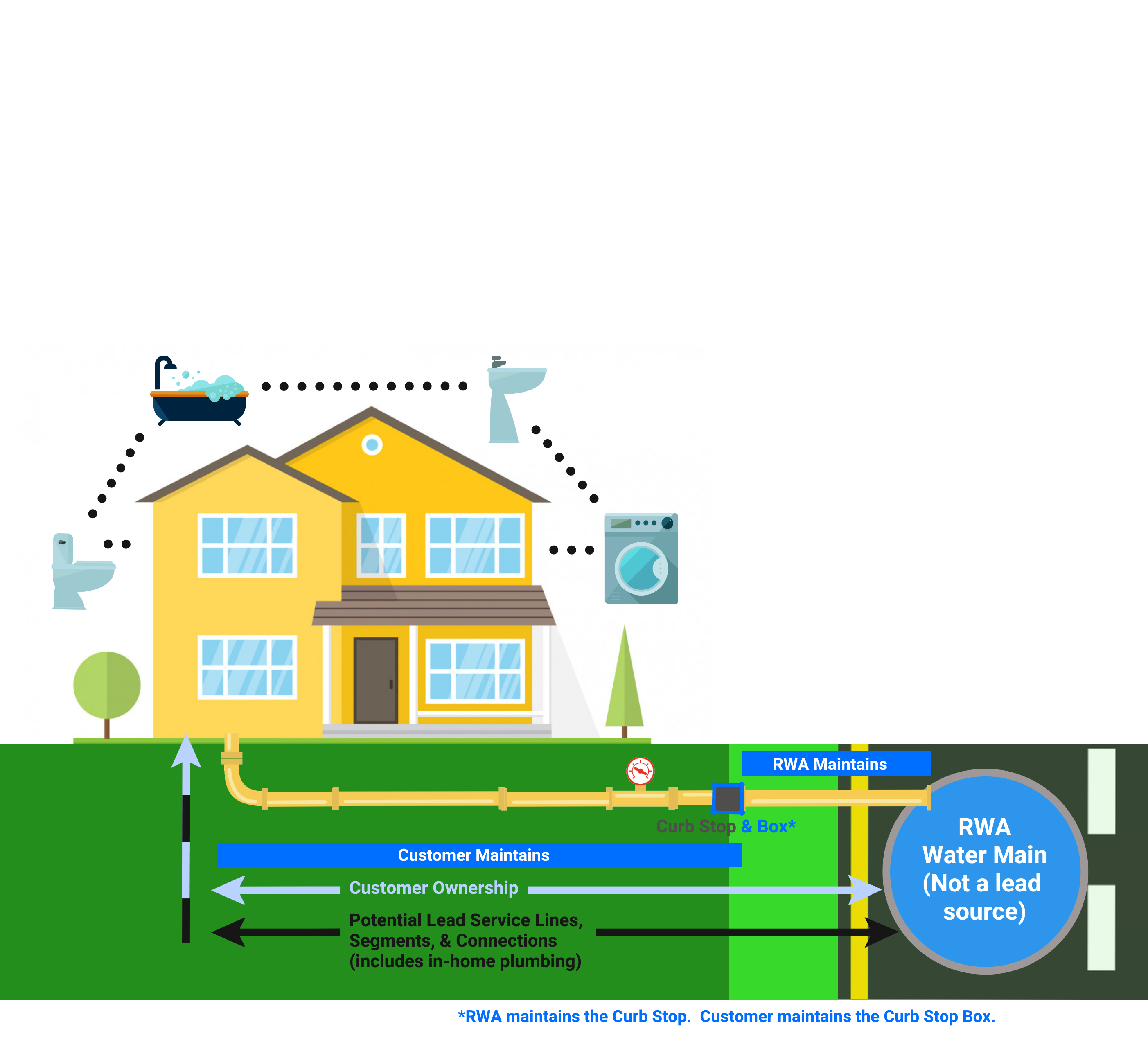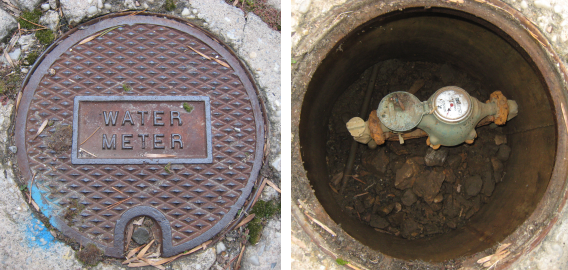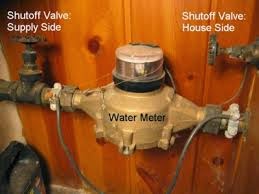Your pipes are probably made of copper
Now that you have identified the material used to make your water service line, please use the link below to report your findings. If you have additional questions, please call 833-RWA-LEAD (833-792-5323)
Report your service line material. This link will take you to our partner website, leadCAST by Trinnex. There you will be asked to create an account before submitting the result of your findings. The information you submit will be used to meet the requirements of the EPA’s new Lead and Copper Rule. For Frequently asked questions about the new lead and Copper Rule and lead in drinking water, please visit our FAQ page.
Find the pipe
It should be 1 inch in diameter and enter the house from a few feet underground before connecting to the water meter. You'll also see a valve on it, which looks something like this.

Found it?
Find your water meter and service line
Walk the shortest path from the water meter to your home. That’s where the pipe will enter your house. Now go inside and find the pipe.
It should be 1 inch in diameter, and have a shutoff valve that looks something like this.

Found it?
THE RWA MATERIAL VERIFICATION SURVEY
The revised Lead and Copper Rule requires us to investigate whether water service lines or connections on or within private customer properties contain lead. The Materials Verification Test below can help you figure out if you have a lead, galvanized steel, copper, or plastic service line on the portion of the service line you own. You won't need anything fancier than a magnet and a coin or screwdriver, but you will need to be at home to follow along.
When you have completed the visual inspection, please submit your results using the link at the bottom of the results page.Completing this survey will help avoid us having to enter your home or dig holes near your property to determine what materials were used to make your service line
You must be at home and have the ability to submit a picture in order to complete the Material Verification Test.
Or, if you know what material was used to make your water service line, Submit Material Now.
You’ve got lead pipes
Don’t worry. To protect you from lead exposure, the RWA adds a corrosion inhibitor to our water that creates a protective coating on our pipes and homeowner’s plumbing. This coating helps prevent lead from potentially leaching into the drinking water. It is proven to be safe and effective, and is approved by the US Environmental Protection Agency and the Food and Drug Administration.
Now that you have identified the material used to make your water service line, please use the link below to report your findings. If you have additional questions, please call 833-RWA-LEAD (833-792-5323)
Report your service line material. This link will take you to our partner website, leadCAST by Trinnex. There you will be asked to create an account before submitting the result of your findings. The information you submit will be used to meet the requirements of the EPA’s new Lead and Copper Rule.
What is a service line?
A service line is an underground pipe that carries water from the RWA’s water main in street to the customers home or business. Typically, this pipe is small, with a diameter of 2 inches or less. A service line and connection may consist of multiple plumbing material types including copper, galvanized iron, lead or plastic.

To find out what your service line is made of, you’ll need a refrigerator magnet, and a key or a coin.
Your pipes are made of plastic
Now that you have identified the material used to make your water service line, please use the link below to report your findings. If you have additional questions, please call 833-RWA-LEAD (833-792-5323)
Report your service line material. This link will take you to our partner website, leadCAST by Trinnex. There you will be asked to create an account before submitting the result of your findings. The information you submit will be used to meet the requirements of the EPA’s new Lead and Copper Rule. For Frequently asked questions about the new lead and Copper Rule and lead in drinking water, please visit our FAQ page.
You might have lead pipes
Don’t worry. To protect you from lead exposure, the RWA adds a corrosion inhibitor to our water that creates a protective coating on our pipes and homeowner’s plumbing. This coating helps prevent lead from potentially leaching into the drinking water. It is proven to be safe and effective, and is approved by the US Environmental Protection Agency and the Food and Drug Administration.
Now that you have identified the material used to make your water service line, please use the link below to report your findings. If you have additional questions, please call 833-RWA-LEAD (833-792-5323)
Report your service line material. This link will take you to our partner website, leadCAST by Trinnex. There you will be asked to create an account before submitting the result of your findings. The information you submit will be used to meet the requirements of the EPA’s new Lead and Copper Rule.
Scratch the pipe
Use the key or coin to scratch the pipe close to where it enters the house through the wall, usually from a few feet underground.
What color is it underneath?
Your pipes are probably galvanized steel
Now that you have identified the material used to make your water service line, please use the link below to report your findings. If you have additional questions, please call 833-RWA-LEAD (833-792-5323)
Report your service line material. This link will take you to our partner website, leadCAST by Trinnex. There you will be asked to create an account before submitting the result of your findings. The information you submit will be used to meet the requirements of the EPA’s new Lead and Copper Rule. For Frequently asked questions about the new lead and Copper Rule and lead in drinking water, please visit our FAQ page.
Okay, so it’s not clear what kind of pipe you have right now
Please call 833-RWA-LEAD (833-792-5323) for help in identifying your service line materials.
Find your water meter

It could be outside, on the sidewalk or in the part of the yard that faces the street, and look something like this. If your meter is outside, you may been a screwdriver or wrench to remove the meter pit lid.
My water meter is outside
Or it could be inside, in the basement, crawlspace or even garage, and look like this.
My water meter is insideYour water meter should say “cubic feet” on the dial, whereas the units on a gas or electric meter will say “kilowatt hours.”
You have lead pipes
Now that you have identified the material used to make your water service line, please use the link below to report your findings. If you have additional questions, please call 833-RWA-LEAD (833-792-5323)
Report your service line material. This link will take you to our partner website, leadCAST by Trinnex. There you will be asked to create an account before submitting the result of your findings. The information you submit will be used to meet the requirements of the EPA’s new Lead and Copper Rule.





